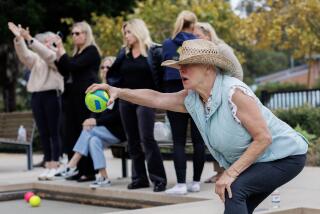HOBO : Laid Off From His Job, Canoga Park’s Boothe Kept Paychecks Coming on Senior Bowling Tour
CANOGA PARK — It could be destiny, coincidence or just dumb luck. Whatever it is, Hobo Boothe will take it and not give it a second thought.
Boothe, a 57-year-old resident of Canoga Park, has put more money in his bank account than any other player on the Professional Bowlers Assn. Senior Tour this year. He has earned $42,322, which was made possible only because he lost his job three years ago.
Boothe, a top amateur bowler in the Valley for several years, had been content working as a shop foreman for a company in Canoga Park that makes business signs.
On a whim in April, 1991, he bowled in two PBA Senior Tour events while on vacation. When Boothe returned to the shop, he was told by his boss at Karman, Ltd. that he and several other employees were being laid off. When the search for another job produced no prospects, Boothe returned to the tour--if for no other reason than to avoid depression.
Boothe has not worked a day since. Now in his fourth year on the tour, he is earning more than the sport’s top players, including several Hall of Famers from the regular PBA tour.
“It’s hard to say,” Boothe said when asked to explain the unlikely turn of events. “I feel very fortunate that I’ve done as well as I have. That’s about the only way I can put it. . . . meant to be or not. I just feel very fortunate.”
The youngest of 12 children raised on a Virginia farm, Boothe worked several different jobs until he entered the sign business in 1970 as a saw operator and moved his way up to supervisor.
While advancing his career, he bowled as many as five nights a week in industrial leagues. And when Boothe beat Rich Moores, 194-184, to win his first PBA Senior championship March 30 in the American Bowling Congress/PBA Senior Masters in Greenacres, Fla., many of his former shop mates--who called Boothe by his middle name, Harmon--were glued to their TV sets.
“If there’s something happening on the senior’s tour, we always look for Harmon’s name,” said Julius Papy, a top official at Karman, Ltd. “When he got into the finals everybody dashed home to watch it on ESPN. Everybody was very proud of him.”
It was a poignant moment, especially for Papy, the man who terminated Boothe’s job.
“Work sort of slowed down and my partner asked me to step in,” Papy said. “Harmon was running production for me and I was overseeing him. There was nothing wrong with his abilities or technical knowledge or loyalty.
“I made a decision to get some supervisory people out of here and keep the people who had their hands on making the product.”
Said Boothe: “I left under good circumstances with them. I knew it three or four months before it happened because they didn’t have any work down there. I had to scrape around to try to find something to keep the guys busy so they wouldn’t get let go earlier.”
The parting might have been amicable, but Boothe--unable to find another job in his field--grew depressed.
“He was just devastated,” said Boothe’s wife, Mary. “It was unreal. I couldn’t even explain it. I think he sort of felt like, ‘What am I going to do now?’
“He had no retirement. He looked for a job maybe a year and a half. Nothing . . . nothing out there.”
So Mary, who started her own insurance agency 11 years ago, decided to sponsor her husband and send him back out on tour.
“This is something he always wanted to do--but he didn’t think he’d ever get the chance,” Mary said. “Now he’s making his dream come true.”
In three-plus years, Boothe has nearly $80,000 in career earnings, not including bonuses and perks from bowling-equipment companies. That might not seem like a fortune, but the PBA Senior Tour, which started in 1981, has never been a big-money sport. John Handegard, a former resident of Thousand Oaks, began 1994 as the all-time earnings leader with $218,282. That included eight championships.
Boothe entered at No. 39 in all-time earnings ($33,710), thanks to several high finishes, or “cashes.”
But money is not what inspires many of the nearly 1,300 PBA Seniors and the estimated 800 who play at least one tournament each year. The idea that, once they’ve turned 50, they can compete against Hall of Famers such as Earl Anthony and Dick Weber is what lures them.
“You want to get out there and beat these guys every time you bowl,” Boothe said.
*
Boothe has at times out-bowled Weber and other Hall of Famers such as Don Johnson, Carmen Salvino and Dave Soutar, who have 86 victories on the regular tour among them.
These upstart seniors--like Handegard, who worked in a saw mill, and rival Gene Stus, a former quality control supervisor for General Motors--come from diverse backgrounds. Boothe’s past is humbler than most.
He was born in a farmhouse in Pulaski, Va., the youngest of six daughters and six sons to Shelley and Stella Boothe. He was given the name Delano, although everyone called him “Hoboy.” The origin of his nickname is uncertain, but, because he is asked so often, Boothe sticks to one explanation.
“When I was little, my father wouldn’t let me work in the fields so I used to carry the tools to my older brothers and sisters,” he said. “I imagine my sister Clara saw me carrying hoses and water out to them, and she just happened to hit the name “Hoboy.”
Boothe shortened it to Hobo when he moved to California in 1962.
The Boothes owned 200 acres on which they grew tobacco, corn, wheat and hay, and raised cows, horses and chickens. In 1956, one year after Hobo became the only child to graduate from high school, the Boothes sold their farm.
Hobo was 6 feet, 205 pounds and a fair athlete. A hard-throwing right-handed pitcher, Boothe couldn’t play his junior year at Auburn High because of a heart murmur, but he had a good senior year. Boothe said he threw a good fastball and his most effective pitch--which he called a “curve-drop”--scared most batters.
“I could throw it right at a guy’s head and it would curve over and sink down right at the plate,” he said. “It was my best pitch.”
Boothe might have gone on to pitch semipro ball, but a shoulder injury wrecked his arm at age 22.
“It got to hurting so much, why, I figured it wasn’t worth it,” he said.
But the acclaim he never received in baseball has come to him in bowling. Since his $38,000 victory in March, television cameras and newspaper reporters have cornered him at every tour stop--more out of curiosity about his name than anything else.
“He’s not a household name yet,” tour press secretary Dick Evans said. ‘His name draws attention. People want to know where he got the name Hobo.”
Evans, who covered bowling for four decades for the Miami Herald, said Boothe reminds him of Handegard, the tour’s top player.
“The key to his success is he keeps himself in shape and practices,” Evans said. “He’s not a sensational bowler. He’s a blue-collar worker. Hobo’s a survivor--and he seems to have a good time out here.”
But Boothe did not have a good time in 1993, a year in which he barely cleared $9,000. He almost quit the tour despite spending the off-season changing his release and shortening his hook in hopes of improving his performance. Instead, he decided to play a limited schedule with the idea of retiring from pro bowling unless he could jump the ladder and increase his paychecks.
“I could throw the ball good, but I couldn’t score last year,” he said. “I was lacking something. I wasn’t competitive enough. To me, you should be in the top 15.”
On the eve of his biggest performance, Boothe was still wavering. He was ready to cancel his travel plans to West Palm Beach, Fla. Had he done so, Boothe would have missed the victory that, Mary said, “probably gave him the biggest lift in his life.”
With the Valley still experiencing strong aftershocks from the Northridge earthquake (in which the Boothes suffered $85,000 in damage and losses to their home), Boothe was concerned about his wife’s safety. He told her he was skipping the Senior Masters tournament.
In a stern tone, Mary told him to start packing.
“Excuse me?” she said. “Oh, yes, you are going. You’re going to bowl this tournament.”
More to Read
Go beyond the scoreboard
Get the latest on L.A.'s teams in the daily Sports Report newsletter.
You may occasionally receive promotional content from the Los Angeles Times.










